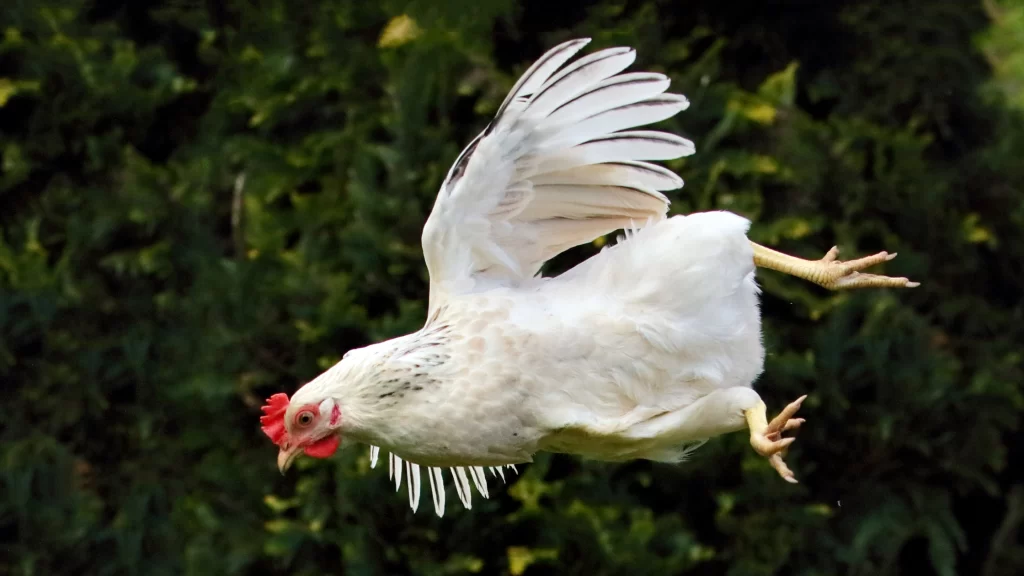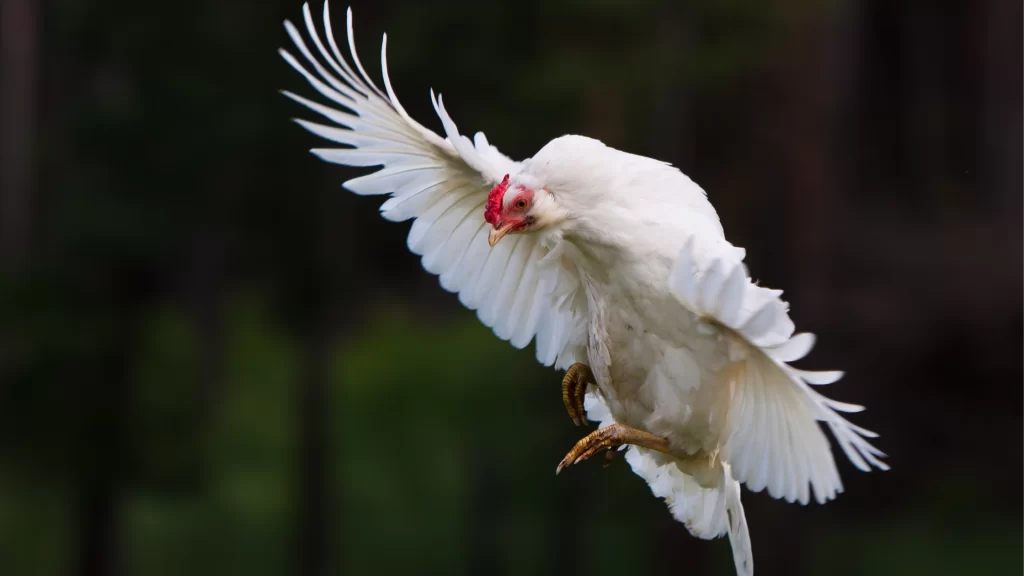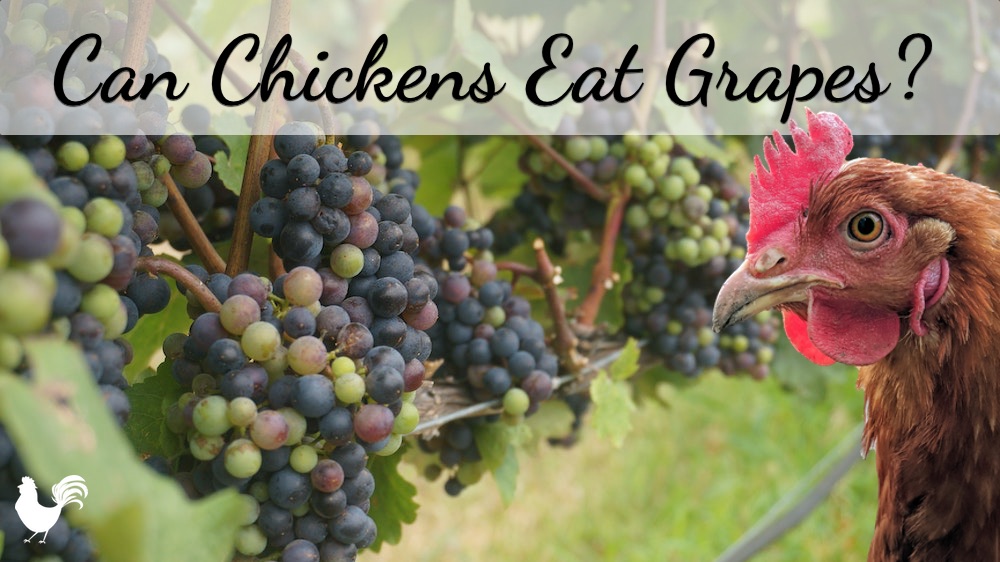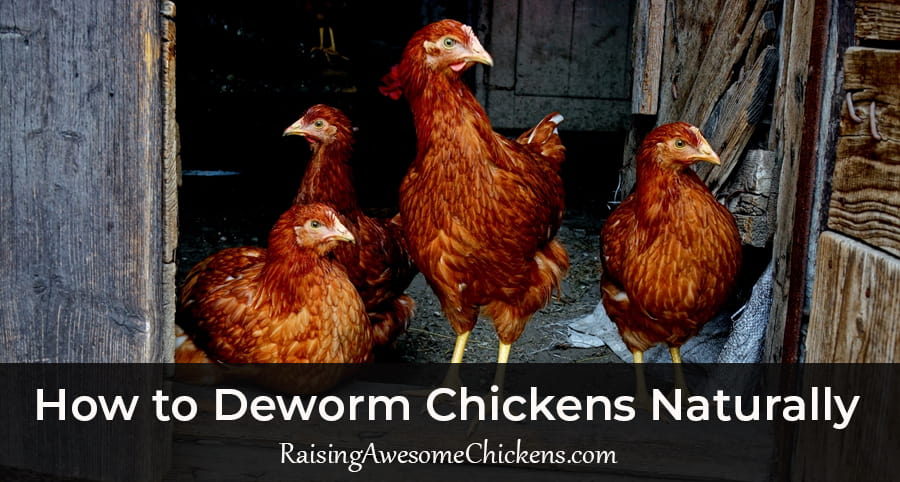Last Updated on February 27, 2024 by AwesomeChickens
Chickens are a common sight in both rural and urban settings, often associated with farm life and known for their eggs and meat. Despite being birds, chickens are not known for their flying abilities. For many new chicken owners, the question of whether chickens can fly might not even cross their minds. After all, when we think of flight, majestic images of soaring birds come to mind, not the humble backyard chicken. However, the truth is that chickens are indeed capable of flight. Albeit in a limited capacity compared to other bird species. Understanding the intricacies of chicken flight can provide valuable insights into their behavior and help owners create safer and more suitable environments for their feathered friends.

Flight in birds is determined by a combination of muscle strength, wing size, and overall body weight. Most bird species have evolved to optimize these factors, allowing them to take to the skies with grace and agility. Chickens, on the other hand, display a different set of physical characteristics. They possess relatively small wing areas compared to their body size, and their breast muscles are not as powerful as those of birds that fly regularly.
While chickens are capable of short bursts of flight, their aerial ability is limited. They can use their wings to flutter above the ground or hop short distances, often to escape predators or to reach a perch. This type of movement is more accurately described as assisted jumping rather than sustained flight. True flight, as exhibited by many other bird species, is beyond the capabilities of most chickens. Their physiology simply doesn’t support the long-distance travel or high altitude flight that the term “flying” suggests.
Table of Contents
Anatomy of Chicken Flight

The flight capabilities of chickens are largely dependent on their anatomy. Specific physical traits of their wings and muscles play a critical role in their capacity for flight.
Wing Structure and Muscles
Chickens possess a wing structure that includes flight feathers and strong muscles geared for short bursts of flapping, which allows for lift and minimal flight. The major flight muscles in chickens are the pectoralis, which powers the downstroke, and the supracoracoideus, responsible for the upstroke. Both muscle groups are well-developed; however, they are not proportioned in a way that supports sustained flight, as in migratory birds. The pectoralis is the larger of the two and attaches to the keel of the sternum, an indication of its importance in generating powerful wing beats.
Breed Variations
Different chicken breeds exhibit varying flight capabilities stemming from their anatomy. Bantam chickens, for example, are lighter with a relatively larger wing area to body weight ratio, which can facilitate better flight than their heavier counterparts. Certain breeds such as the Leghorns are known for their better flying abilities among domestic chickens, which can be seen as a remnant trait from their wild ancestors like the Red Junglefowl.
Conversely, heavier breeds like Orpingtons and Silkies are less adept at flying due to a larger body mass and smaller wing span in relation to their weight. Breeds such as Leghorn, Old English Game, and Araucanas also show variation in flight capabilities, closely tied to the balance between their body mass and wing strength. Breeds like Silkies are noted for their striking plumage. Still, due to their unique feather structure, these physical characteristics serve more for show than for function, providing insufficient lift and aerodynamics necessary for flight.
Flight Capabilities and Behaviors
Chickens exhibit a form of limited flight, mainly used for escaping predators and navigating their environment.
Range and Duration
Chickens are capable of short bursts of flight, often just long enough to reach safety. They can cover distances up to 301.5 feet, but typically fly just 10 to 50 feet. The duration of their flight is usually a matter of seconds.
Predatory Escape and Roosting
In response to threats, chickens utilize flight as a means of escape, often taking refuge in trees or on fences. Their flights are not sustained, but they can reach impressive speeds. At dusk, chickens instinctively roost in heightened locations to evade nocturnal predators.
Environmental Navigation
Domesticated chickens use flight to navigate backyard environments, often flying over fences to explore or access food. They may also fly to reach the safety of their coop or a neighbor’s roof. Free-range chickens exhibit behaviors reminiscent of their wild ancestors, venturing short distances and returning to roost.
Human Influences on Chicken Flight

Human interventions have had significant effects on the flight capabilities of chickens. These interventions encompass selective breeding practices aimed at enhancing specific traits, as well as physical modifications and containment measures.
Selective Breeding
Selective breeding has played a pivotal role in the evolution of domesticated chickens. Historically, species like the Old English Game were bred for their agility and ability to fly, possessing characteristics akin to their wild counterparts. However, modern domestication efforts have largely focused on developing breeds for meat and egg production. This shift has led to the predominance of heavier breeds with less emphasis on flight, resulting in birds that are more flightless than flighty.
- Meat Production: Breeds like the Broiler have been selected for rapid growth and large breast muscles, trading off their ability to fly.
- Egg Production: Layers are bred for optimum egg output, often at the expense of physical attributes necessary for sustained flight.
Breeding for such traits has curtailed the flight prowess that chickens ancestrally possessed, essentially classifying them alongside other flightless birds like emus, though still capable of short bursts of flight.
Wing Clipping and Containment
Wing clipping and containment strategies are human-imposed controls that directly impact a chicken’s ability to fly. This is a common practice whereby flight feathers of one wing are clipped to unbalance the bird. This makes it difficult for them to gain lift. This technique is practiced primarily in backyard settings and small farms. The goal is to prevent chickens from flying out of their enclosures or into danger. If done correctly, it poses no pain or risk to the chicken.
- Clipped vs. Unclipped: A clipped chicken cannot fly over fences or escape predators by flying. On the other hand, unclipped birds retain some flight ability.
- Brailing: Less common and not as safe as clipping, brailing involves restraining one wing to keep chickens grounded.
Containment further influences chicken flight. Coops and runs are designed to protect domesticated animals from predators and prevent escape.
- Chicken Runs: Often enclosed with chicken wire, these are designed to provide chickens with outdoor access. However, the run restricts their movement within a safe area.
- Covered Runs: Some runs are covered, to ensure that even unclipped birds cannot escape and are safe from aerial predators.
These human-implemented measures illustrate the extensive impact humans have had in shaping the flight capabilities of domestic chickens for safety and management purposes.




